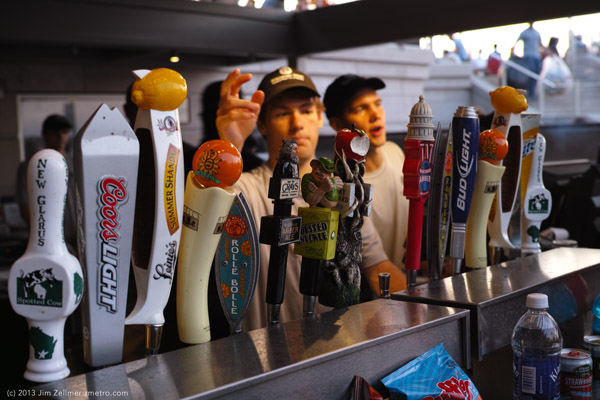The biggest problem for Palantir’s business may be just how well its software works: It helps its customers see too much. In the wake of NSA leaker Edward Snowden’s revelations of the agency’s mass surveillance, Palantir’s tools have come to represent privacy advocates’ greatest fears of data-mining technology — Google-level engineering applied directly to government spying. That combination of Big Brother and Big Data has come into focus just as Palantir is emerging as one of the fastest-growing startups in the Valley, threatening to contaminate its first public impressions and render the firm toxic in the eyes of customers and investors just when it needs them most.
“They’re in a scary business,” says Electronic Frontier Foundation attorney Lee Tien. ACLU analyst Jay Stanley has written that Palantir’s software could enable a “true totalitarian nightmare, monitoring the activities of innocent Americans on a mass scale.”
Karp, a social theory Ph.D., doesn’t dodge those concerns. He sees Palantir as the company that can rewrite the rules of the zero-sum game of privacy and security. “I didn’t sign up for the government to know when I smoke a joint or have an affair,” he acknowledges. In a company address he stated, “We have to find places that we protect away from government so that we can all be the unique and interesting and, in my case, somewhat deviant people we’d like to be.”
The Giants of Boston
Boston is a city perennially self-conscious about public art. A 2012 Boston Phoenix cover story examined why such an alarming number of young artists leave a city ranked in the top 10 for national arts funding. (The Boston Phoenix itself folded not long after that publication.) When it comes to large-scale works in the public domain, the city tends to favor exogenous creations rather than the homegrown. The accusation that the city is risk-averse and WASP-y descends from what Michael Braithwaite called an “age-old attitude central to the very culture of Boston itself: a city where philanthropy as historically been dedicated to institutions and fine art, rather than to visual art and artists that push boundaries.” More important, the elimination of rent control by voter referendum in 1994 ensured that tenable housing for artists, the vast majority of whom piece together low wages, would be dispiritingly low.This essay appears in TNI Vol. 19: “Art,” out now. Subscribe for $2 and get it.
The most publicly discussed artwork on the heels of that 2012 report was “The Giant of Boston,” a large mural by Os Gêmeos (Portuguese for “the twins”). Otávio and Gustavo Pandolfo are Brazilian brothers from São Paulo who co-produce all their work, both sanctioned and illicit, as the eponymous twins, signing their entire jointly bred oeuvre as a single artist. Os Gêmeos’ local work comprised three murals around the city and an exhibition at the Institute of Contemporary Art, the most prominent artistic institution in Boston.
Millennials Lead the Trend to Less Driving, But What Happens As They Get Older?
It is unquestionably true that Americans are driving less today than we did just a few years ago. Sometime around 2004, our addiction to driving – expressed on a graph in the decades-long steep expansion of “vehicle miles traveled” – took a turn in the opposite direction. Per capita, we began to drive fewer miles each year than we had the year before. As the U.S. population has continued to grow, our collective miles traveled by car has begun to stagnate.
We still don’t really know how bicycles work
Forget mysterious dark matter and the inexplicable accelerating expansion of the universe; the bicycle represents a far more embarrassing hole in the accomplishments of physics.
Let’s be honest, a bit of the pleasure at Chris Froome’s victory in the Tour de France is down to this being our second victory in a row and to the thought that the French haven’t won it since 1985. What must be worse for them, though, is that when it comes to the science of team cycling, even the Belgians are in front.
At the University of Mons, researchers are developing something called the Anaconda. It’s never going to be much of a speed machine because it is, in effect, a chain of monocycles with handlebars. These units are connected, by means of hinges that allow them to snake along, to a normal two-wheeled bike at the front. Every rider in the chain can be going in a slightly different direction, which means it takes an enormous amount of control and collaboration to move the thing forward. According to Olivier Verlinden, chief engineer on the project, the main qualification for riders is to be unafraid of falling off.
It’s fun, apparently. The idea is to unleash it as a beach-resort bike, the kind of thing that stag and hen parties will use to terrorise seaside towns across the world. But it is also scientifically interesting. Why? Because we still don’t really know how bicycles work.
American surveillance: The Snowden effect
THERE was something surreal, in a Kafkaesque sort of way, about Barack Obama’s press conference on August 9th. Aiming to ease concern over the government’s surveillance programmes, the president announced reforms that seem both obvious and overdue. Then he criticised the man whose actions set those reforms in motion.
The president’s proposals include creating a group of outside experts to assess the government’s balancing of security and privacy. (When in doubt, create a task force.) More substantially, Mr Obama said he would like to change the proceedings of the secret court that approves electronic spying and interprets counterterrorism laws. Whereas now the court only hear’s the government’s side of any argument, the president wants to see an opposing viewpoint represented.
Mobile phone drivers ‘not linked’ to accident figures
BBC:
Researchers have found no link between the number of US drivers making phone calls while on the road and the number of accidents recorded.
A team at Carnegie Mellon University and the London School of Economics analysed more than eight million incidents of car crashes and all fatalities on roads in eight US states.
They examined data before and after 9pm local time over a three-year period.
However they say their results do not include texting or internet browsing.
The timeslot was chosen because during the period studied (2002 – 2005) many American mobile phone operators offered free calls after 9pm during the week.
The Great Debate: Do Millennials Really Want Cars, Or Not?
Why are young people less likely to purchase cars, or even have driver’s licenses nowadays? One theory has it that the generation that came of age with the Internet and smartphones thinks cars are pretty lame. Automakers prefer to see the situation differently—that young people today love cars just as much as any other group, but just can’t afford them right now.
The auto industry has been in recovery mode over the past few years. Automakers sold 14.5 million new cars and trucks in 2012, a 13% increase over the prior year, and the highest total since 2007. Projected auto sales totals for 2013 should easily beat last year too, topping 15 million. Even so, the comeback has been called a “subpar recovery,” and a prime reason why sales haven’t truly taken off is that younger consumers today aren’t buying cars like younger consumers traditionally have in the car-crazed U.S.
Gen Y has been dubbed “Gen N”, as in Generation Neutral—which is the way some describe how millennials feel about car ownership. Studies have shown that fewer young adults have driver’s licenses, that this group hates the traditional car-buying process more than other demographics, and that they prefer urban living and socializing online and therefore have less need for cars.
The latest data from the University of Michigan’s Transportation Research Institute (UMTRI) bolsters the idea that younger Americans are much less interested in car ownership than their older siblings, parents, and grandparents. Bloomberg News highlighted data from the study showing that while consumers in the 35-to-44 age demographic were the most likely to be purchasing new cars four years ago, today it’s the 55-to-65 age Baby Boomers buying new cars with the most frequency. In 2011, boomers were 15 times more likely to purchase new vehicles than young millennials (ages 18 to 24), and even consumers ages 75 and up have been buying cars at higher rates than groups ages 18 to 24 and 25 to 34.
Excellent Draft Beer Choices at the University of Wisconsin Union Terrace

I have a preference for Gray Brewing’s Rathskeller Ale.
The terrace view is a bit different in March, particularly when the Statue of Liberty pays a visit.
DJ @ Wisconsin Union Terrace Sunset
Driverless tractors till high-tech farms
AAP:
“Of 280,000 farms in Germany, between 800 and 1,000 use optical sensors,” he says.
However, precision agriculture may have bumper times ahead.
“It offers enormous productivity gains and allows for a reduction of resource use at a time of growing environmental regulatory demands,” said Oliver Neumann, spokesman for agricultural equipment giant John Deere.A problem is that the equipment still doesn’t come cheap. Some high-tech combine harvesters can cost up to half a million euros.
